Mottainai is an Action Selection, Tableau Building game.
Title: Mottainai
Year Published: 2015
Designer: Carl Chudyk
Publisher: Asmadi Games
Players: 2-3 (2-5 with 2 sets)
Game Time: ~30 mins
Set-up Time: ~3 mins
Ages: 13+
Theme: Japan
Mechanic: Action Selection, Tableau Building, Hand Management, Set Collection
How to win: Score the most points.
Game Description
Mottainai” (pronounced mot/tai/nai or like the English words mote-tie-nigh) means “Don’t waste“, or “Every little thing has a soul”. In the game Mottainai, a successor in the Glory to Rome line, you use your cards for many purposes. Each player is a monk in a temple who performs tasks, collects materials, and sells or completes works for visitors.
Mottainai Set-Up
This is simple, it’s the only part of the game that’s simple 🙂
Give each player a large Temple card and a hand of 5 regular cards. Then each player puts an additional card face down under their Temple in the task slot.
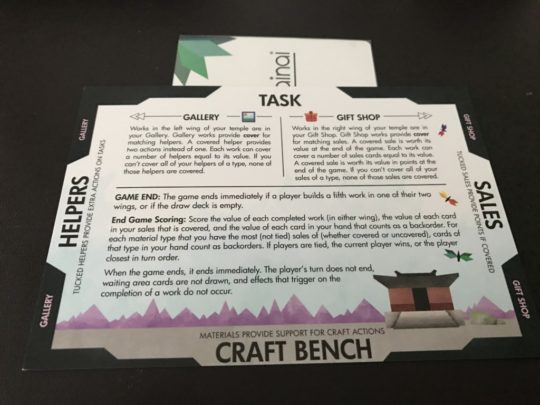
Each player discards a card from their hand to the Floor (The Floor is a mass of cards in the middle of the table), the card closest to ‘A’ goes first.
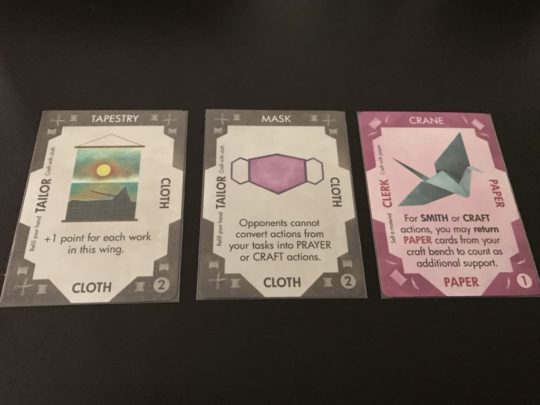
Play Area and Card Info
Before gameplay, let’s look at the things we have available.
The Temple, your main player board is full of most of the information needed to play the game.
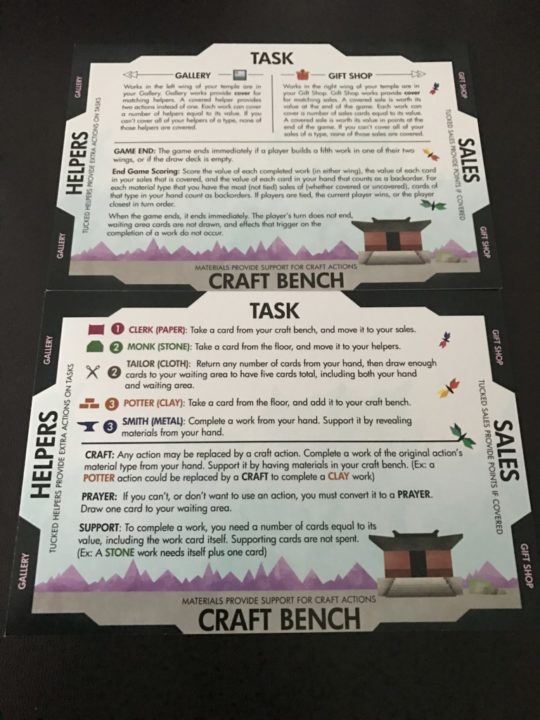
The Task shows which Tasks you can do, Helpers give you an extra action when performing the matching Task, Sales is essentially your score pile and the Craft Bench is where you store materials that let you complete works.
This will all make sense by the end 🙂
So, where a card is will determine what the card does… The value on the card refers to both how many points it’s worth AND how many Materials you need to complete it.
The Material Type is just the material type, nothing tricky there.
Completed Works are placed next to your Helpers (called the Gallery) or Sales (called Gift Shop)
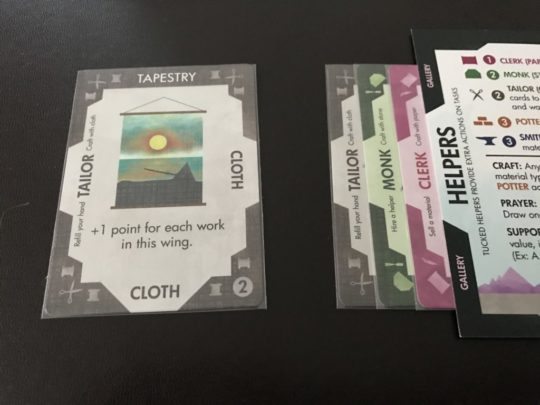
Another area of the game is your own personal waiting area where you put cards you have drawn this turn, face down. You don’t draw cards into your hand in this game, you to wait until the Night phase.
Mottainai Game Play
The gameplay is easy if you use these great turn reference cards, let’s follow one for our first turn…
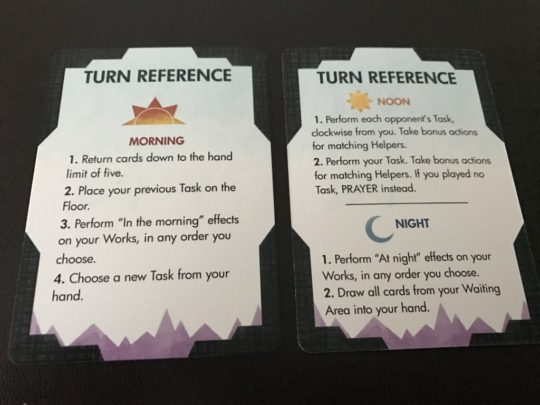
There are 3 phases, Morning, Noon and Night and you start as every day does, in the Morning
This means ‘Returning’ cards from your hand in excess of 5. There is no discard pile in this game; cards are ‘returned’ to the bottom of the deck, face down, in any order.
Then the card you have in your Task slot is discarded to the floor. You start the game with one face down in the Task slot so that card is discarded to the floor face up.
Any completed works that have ‘In the Morning’ effects do their thing, like the Bowl.
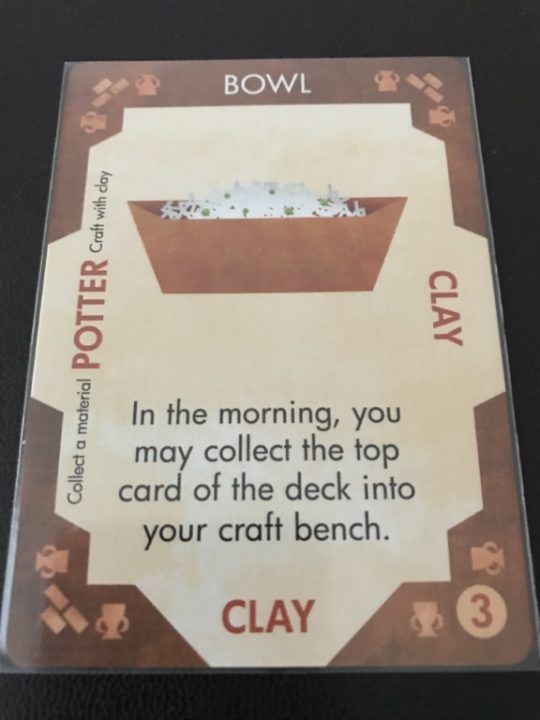
Then you put a new Task card into your Temple from your hand.
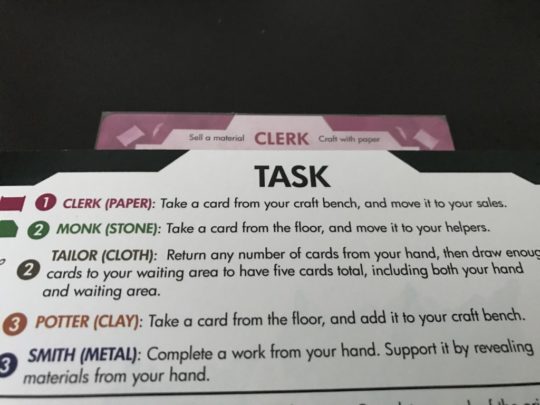
As you can tell the Morning phase is a ‘cleanup and setup’ phase for the serious meat phase, Noon.
This is the phase where you complete actions on the Task cards but you don’t start with your own, you start with the player on your left. You take the action of the task they have shown in their Temple, and proceed clockwise taking each task in order eventually taking your own last.
Let’s look at each Task, what it does and why you’re doing it.
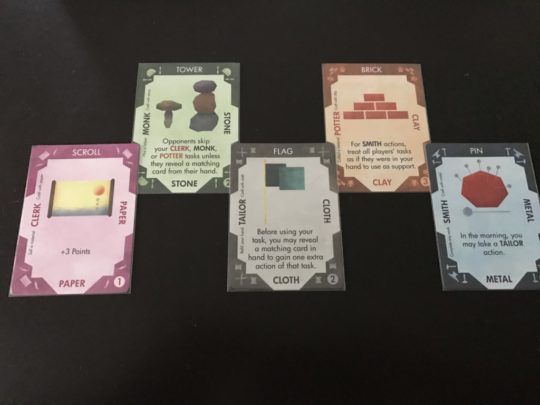
Actions
Clerk – Move a card from your Craft bench to your Sales
Monk – Move a card from the Floor to your Helpers
Tailor – ‘Return’ any number of cards from your hand, draw cards into your waiting area until you have a total of 5 cards between your waiting area and your hand
Potter – Move a card from the Floor to your Craft Bench
Smith – Complete a Work (build a card) from your hand, support it by revealing Materials from your hand (more on that in a bit)
So the first 4 are moving/drawing cards and the last one is building a card.
You do these Tasks once plus one more each covered (more on that later) Helper of the same type too, so if you use the Clerk Task and have 2 covered Clerk Helpers, you can move 3 cards from your Craft bench to your Sales.
But, you essentially have, in this example, 3 ‘Action Points’ for lack of a better phrase and you MUST use all of these available actions.
You can use the Task action as many times as you wish, the remaining actions can be used to Craft or use the Prayer action.
Prayer is simple, you draw a card to your Waiting Room so you can always take all of your available actions just by drawing cards.
Crafting
Craft is also ‘Completing a Work’, but it’s different from the regular Smith action…
To Craft, you complete a work from your hand that matches the Material type of the Task and you need Materials in your Craft Bench.
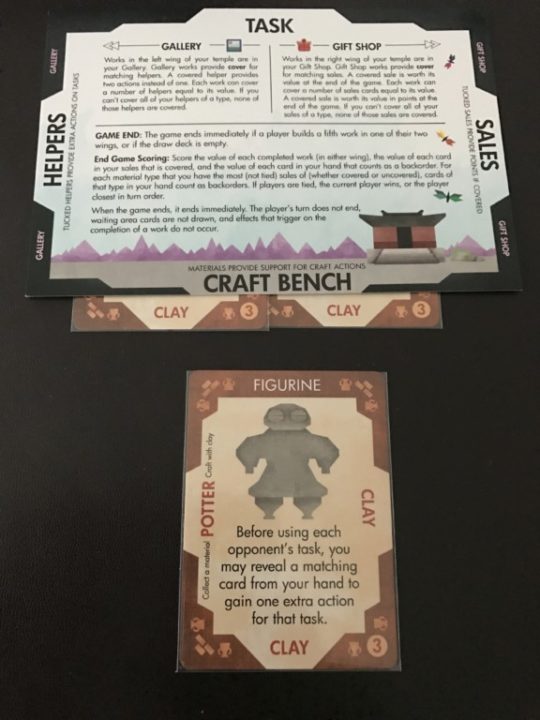
To Smith, you complete a Work from your hand of any type but you reveal (not discard) Materials from your hand.
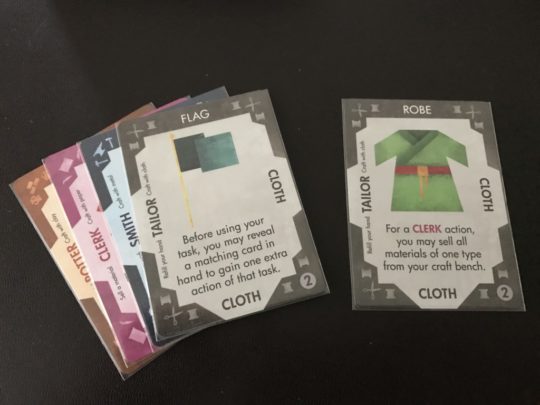
In both cases, the card you want to build counts as a resource for itself. So the above Robe costs 2 Cloth so you can use the Flag and Robe as the 2 resources required.
Helpers & Sales
A completed Work in each Wing provides cover for both Helpers and Sales. The number of cards of its type that it covers is equal to its value.
Covered sales are worth victory points but if you can’t cover all your Sales of a single type, none of them counts as being covered.
Any Helpers that are covered give you an additional action of that type but if you can’t cover all your Helpers of that type, none of them counts as being covered.
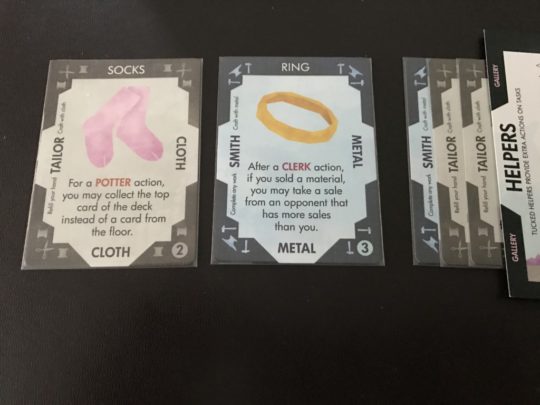
After Noon, it’s time for Night.
Any completed works that have ‘At Night’ effects do their thing, like the Pinwheel.

Then you put any cards in your waiting area into your hand.
Play continues clockwise.
Game End
If the deck of cards ever runs out or one player completes 5 works on one wing (6 in a 4/5 player game) the games will end IMMEDIATELY, the active player doesn’t even finish their turn.
You then score.
Points
You score the value of completed works in the Gift Shop and the gallery.
You score the points for your covered sales.
Check each Material in your Sales (covered or uncovered), the player with the most counts each card in their hand of that type as a ‘Backorder’ and are worth their value in points. If there is a tie, no one gets any Backorder points for that material type.
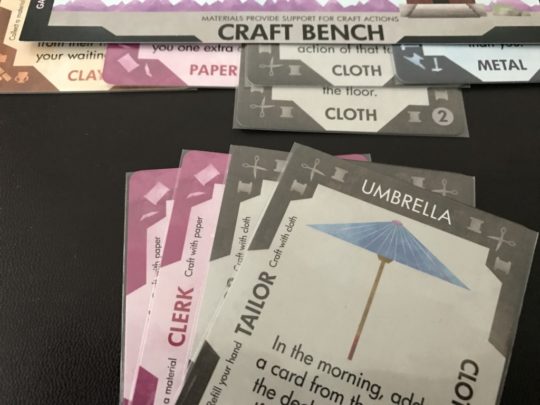
Some completed works have effects which give end game points, remember to score these.
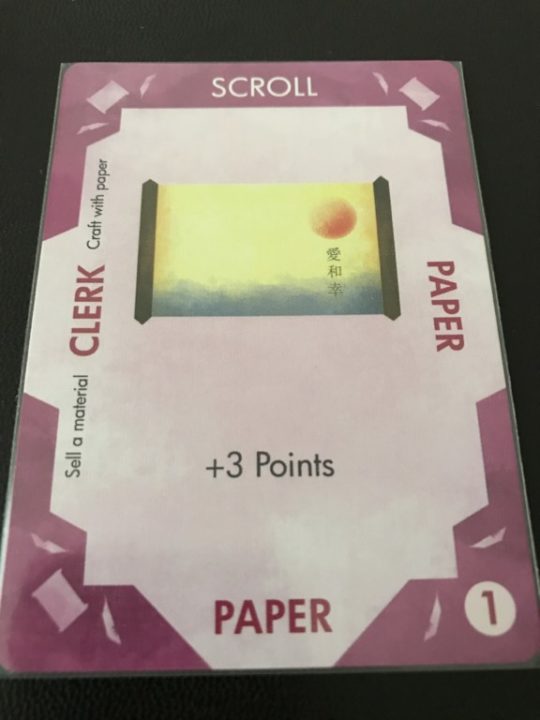
Most points wins. In the case of a tie, the currently active player, or the closest player in turn order wins.
Round-Up
First up, the game comes in two versions: Mini and Deluxe.
The Deluxe box is basically 2 decks of cards exactly the same that allows you to play with up to 5 players. The Mini version is one deck so you can play with 2 or 3 players. I have the Deluxe version although I prefer it with 3 players and a single deck of cards.
But, this is the hardest game I have to teach and despite its cutesy look and fairly simple rules. I think it’s because it’s so different and doesn’t meet the ‘Norms’ of gaming unless you know it’s predecessors Glory to Rome and Uchronia.
But once you understand it, and you get how to score its a lot of fun.
You can build combos, try different cards and see what happens… There are only 54 in the deck but as you use some as Helpers, some as Materials, some as Sales etc you won’t get to use them all as completed works for their ability.
Rating
I love to play this game, hate to teach it.
I give it 6/10
Mottainai First Impressions December 2015
Glory to Rome is too hard to get, Uchronia is colour-horrific.
Bring on Mottainai!
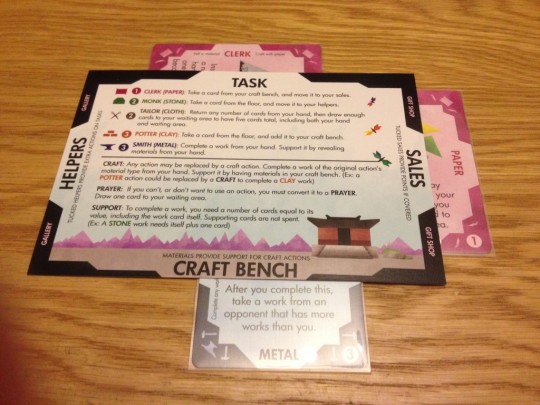
I’m not going to try and explain it any more than that. If you want to know more there are good tutorial videos or my reviews of Glory to Rome and Uchronia explain things in a bit more detail.
Now we’ve played it once and it took an hour, we feel the next game will be 15-20 minutes. It’s VERY simple and turns are quick despite taking 4 actions per turn.
It’s really just getting the understanding of what cards go where, and when, and how to score… scoring is quite complex.
This isn’t a long game, but it is difficult to comprehend (and teach), more so than the others.
It’s pretty though 🙂
Jesta ThaRogue
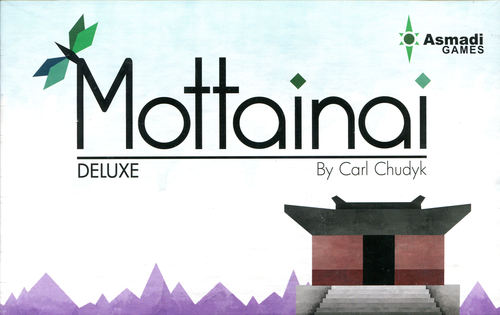

Leave a Reply